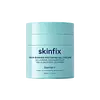Authentic Ego Super Sensa Barrier Repair Moisturizer With Ectoin & Panthenol + PDRN Versus Skinfix Barrier+ Skin Barrier Restoring Gel Cream
What's inside
What's inside
 Key Ingredients
Key Ingredients

 Benefits
Benefits

 Ingredients Side-by-side
Ingredients Side-by-side

Water
Skin ConditioningSqualane
EmollientPanthenol
Skin ConditioningPropanediol
SolventEctoin
Skin ConditioningGlyceryl Glucoside
HumectantBetaine
HumectantAmmonium Polyacryloyldimethyl Taurate
Emulsion StabilisingCyclopentasiloxane
EmollientXylitylglucoside
HumectantAnhydroxylitol
HumectantXylitol
HumectantInulin
Skin ConditioningAlpha-Glucan Oligosaccharide
CleansingAcetyl Heptapeptide-4
HumectantBenzylsulfonyl D-Seryl Homophenylalanine Amidinobenzamide Acetate
Skin ConditioningPolyglutamic Acid
Skin ConditioningSodium Dna
Skin ConditioningTrehalose
Humectant1,2-Hexanediol
Skin ConditioningCaprylhydroxamic Acid
Tremella Fuciformis Sporocarp Extract
AntioxidantCaprylyl Glycol
EmollientTocopheryl Acetate
AntioxidantWater, Squalane, Panthenol, Propanediol, Ectoin, Glyceryl Glucoside, Betaine, Ammonium Polyacryloyldimethyl Taurate, Cyclopentasiloxane, Xylitylglucoside, Anhydroxylitol, Xylitol, Inulin, Alpha-Glucan Oligosaccharide, Acetyl Heptapeptide-4, Benzylsulfonyl D-Seryl Homophenylalanine Amidinobenzamide Acetate, Polyglutamic Acid, Sodium Dna, Trehalose, 1,2-Hexanediol, Caprylhydroxamic Acid, Tremella Fuciformis Sporocarp Extract, Caprylyl Glycol, Tocopheryl Acetate
Water
Skin ConditioningSqualane
EmollientPropanediol
SolventJojoba Oil/Macadamia Seed Oil Esters
Skin ConditioningTriheptanoin
Skin ConditioningNiacinamide
SmoothingSaccharide Isomerate
HumectantAmmonium Acryloyldimethyltaurate/Vp Copolymer
Squalene
EmollientZinc PCA
HumectantHydrolyzed Hyaluronic Acid
HumectantGlycerin
HumectantCamellia Sinensis Seed Extract
HumectantAllantoin
Skin ConditioningPhytosteryl Macadamiate
Skin ConditioningPhytosterols
Skin ConditioningAcetyl Glutamine
Skin ConditioningLecithin
EmollientCaprylyl Glycol
EmollientAmylopectin
Sodium Hyaluronate
HumectantFolic Acid
Skin ConditioningOligopeptide-3
Skin ConditioningBacillus/Soybean Ferment Extract
Skin ConditioningOligopeptide-1
Skin ConditioningOligopeptide-2
Skin ConditioningHexapeptide-11
Skin ConditioningTocopherol
AntioxidantLithothamnion Calcareum Extract
Skin ConditioningLactic Acid
BufferingGlucose
HumectantAcetyl Heptapeptide-4
HumectantC14-22 Alcohols
Emulsion StabilisingC12-20 Alkyl Glucoside
EmulsifyingEthylhexylglycerin
Skin ConditioningTrisodium Ethylenediamine Disuccinate
Potassium Sorbate
PreservativeCitric Acid
BufferingSodium Citrate
BufferingPentylene Glycol
Skin ConditioningSodium Benzoate
MaskingXanthan Gum
EmulsifyingPhenoxyethanol
PreservativeWater, Squalane, Propanediol, Jojoba Oil/Macadamia Seed Oil Esters, Triheptanoin, Niacinamide, Saccharide Isomerate, Ammonium Acryloyldimethyltaurate/Vp Copolymer, Squalene, Zinc PCA, Hydrolyzed Hyaluronic Acid, Glycerin, Camellia Sinensis Seed Extract, Allantoin, Phytosteryl Macadamiate, Phytosterols, Acetyl Glutamine, Lecithin, Caprylyl Glycol, Amylopectin, Sodium Hyaluronate, Folic Acid, Oligopeptide-3, Bacillus/Soybean Ferment Extract, Oligopeptide-1, Oligopeptide-2, Hexapeptide-11, Tocopherol, Lithothamnion Calcareum Extract, Lactic Acid, Glucose, Acetyl Heptapeptide-4, C14-22 Alcohols, C12-20 Alkyl Glucoside, Ethylhexylglycerin, Trisodium Ethylenediamine Disuccinate, Potassium Sorbate, Citric Acid, Sodium Citrate, Pentylene Glycol, Sodium Benzoate, Xanthan Gum, Phenoxyethanol
 Reviews
Reviews

Ingredients Explained
These ingredients are found in both products.
Ingredients higher up in an ingredient list are typically present in a larger amount.
Acetyl Heptapeptide-4 is a peptide with hydrating properties.
According to a manufacturer, a combination of this ingredient and caprylyl glycol strengthens the skin barrier by keeping your skin's natural biome in balance.
Caprylyl Glycol is a humectant and emollient, meaning it attracts and preserves moisture.
It is a common ingredient in many products, especially those designed to hydrate skin. The primary benefits are retaining moisture, skin softening, and promoting a healthy skin barrier.
Though Caprylyl Glycol is an alcohol derived from fatty acids, it is not the kind that can dry out skin.
This ingredient is also used as a preservative to extend the life of products. It has slight antimicrobial properties.
Learn more about Caprylyl GlycolPropanediol is an all-star ingredient. It softens, hydrates, and smooths the skin.
It’s often used to:
Propanediol is not likely to cause sensitivity and considered safe to use. It is derived from corn or petroleum with a clear color and no scent.
Learn more about PropanediolSqualane is an emollient that helps the skin hold onto moisture. It's an oily liquid that occurs naturally in certain types of fish and plant oils.
Because squalane boosts hydration in the skin, it also comes with plenty of benefits: it is an antioxidant and can help fight free radicals and skin damage. Squalane is also found to have a detoxifying effect when applied.
Squalane comes from squalene, which occurs naturally within the sebum of our skin. It is one of the oils our skin produces to keep itself hydrated. Squalane is the hydrogenated version of squalene and has a longer shelf life.
Research shows that squalane is non-irritating (even at 100% concentration).
In general, it's a fantastic ingredient. It does a great job at hydrating the skin, and it's suitable for those with sensitive skin.
The source of squalane may impact malassezia / fungal acne. This is because olive oil derived squalane can contain impurities such as fatty acids and plant waxes. Sugarcane derived squalane is recommended for anyone with malassezia concerns.
Is squalane vegan?
This depends on the source. Squalane can be derived from both plants and animals. Most squalane used in skincare comes from plants.
Please note: the source of squalane is only known if disclosed by the brand. We recommend reaching out to the brand if you have any questions about their squalane.
Read more about squalene with an "e".
Is squalane an oil?
Squalane is often called an oil, but it’s technically not; it’s a hydrocarbon, meaning it’s only made of carbon and hydrogen, unlike true oils which are triglycerides made of fatty acids and glycerol.
The term “oil-free” isn’t regulated, so companies can define it however they want. Some exclude all oils, while others just avoid mineral oil or comedogenic oils.
While some people avoid oils thinking they cause breakouts, the right kind of oil (or oil-like ingredient like squalane) can actually help balance and hydrate your skin. It’s worth testing out simple oils or squalane to see what works best for your skin.
Learn more about SqualaneWater. It's the most common cosmetic ingredient of all. You'll usually see it at the top of ingredient lists, meaning that it makes up the largest part of the product.
So why is it so popular? Water most often acts as a solvent - this means that it helps dissolve other ingredients into the formulation.
You'll also recognize water as that liquid we all need to stay alive. If you see this, drink a glass of water. Stay hydrated!
Learn more about Water